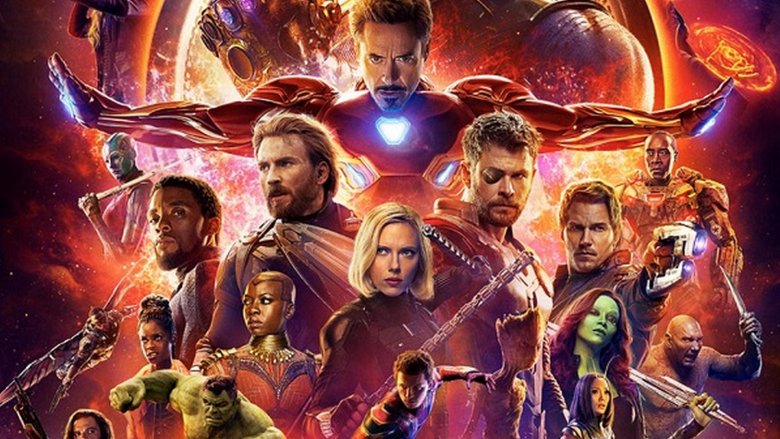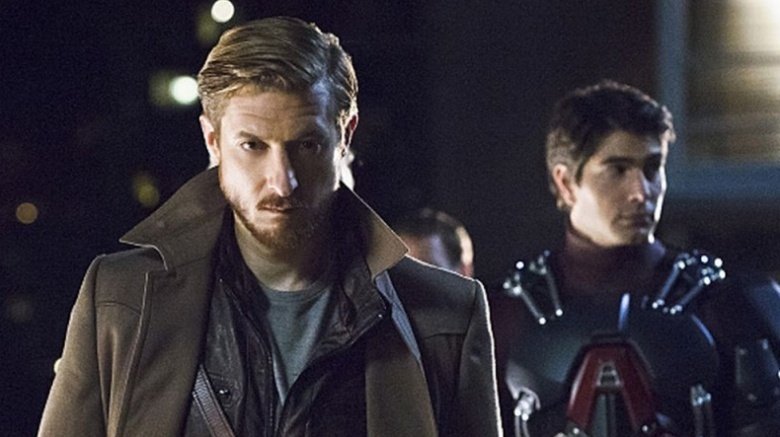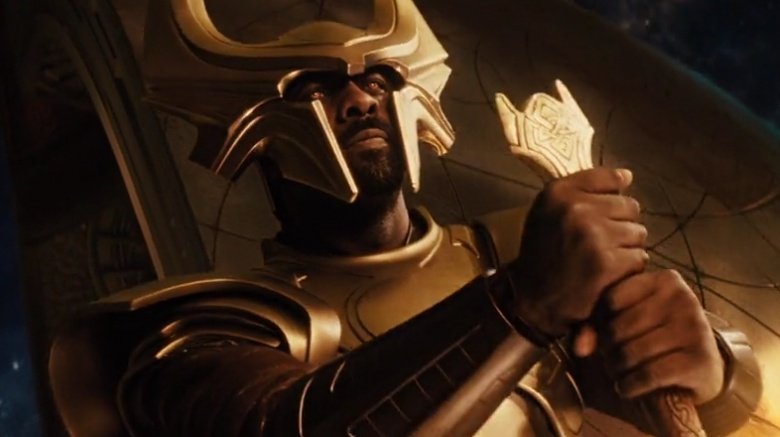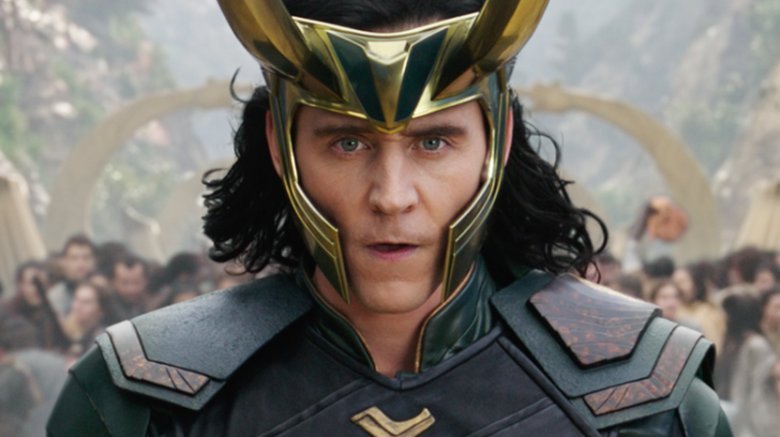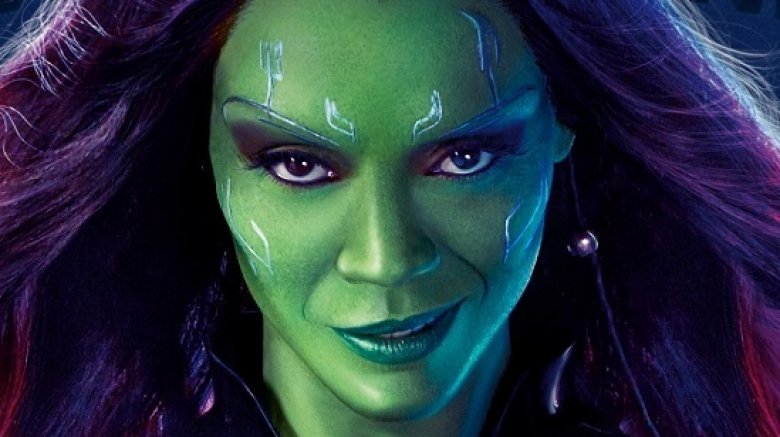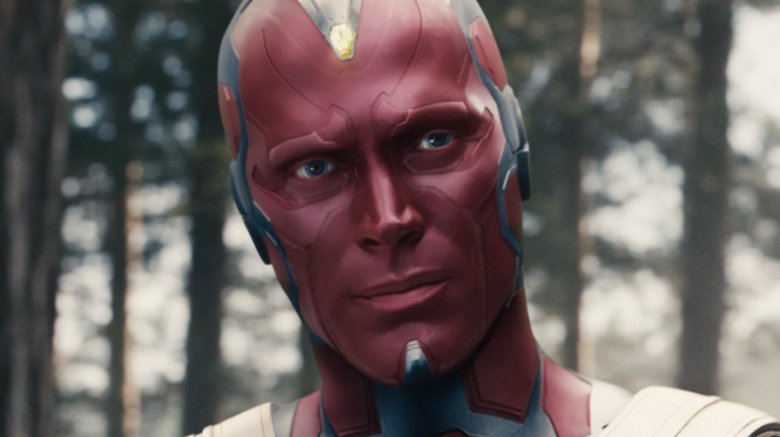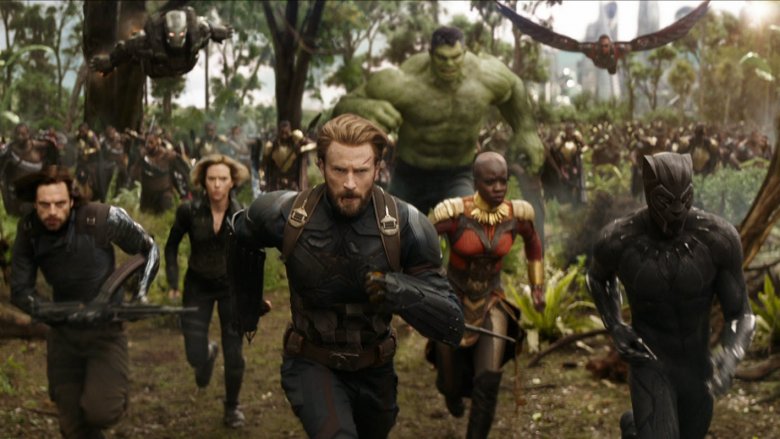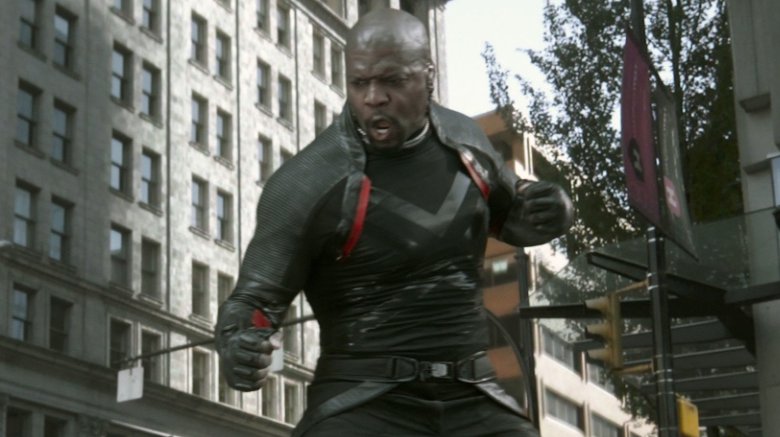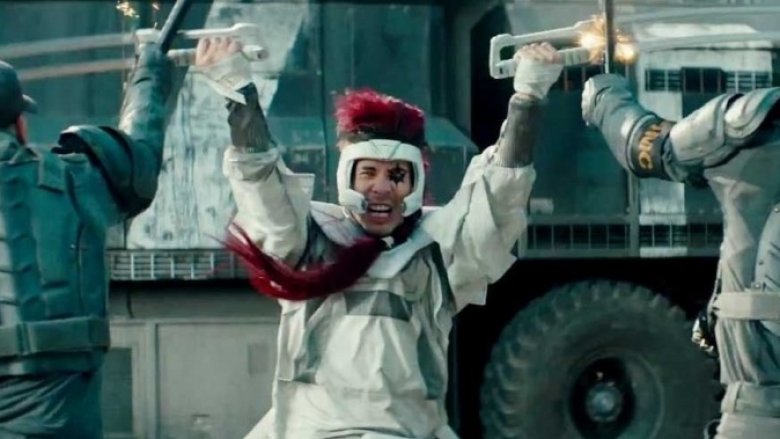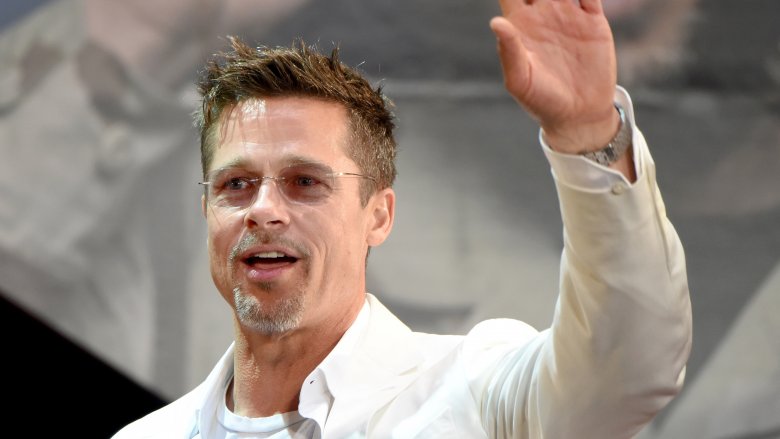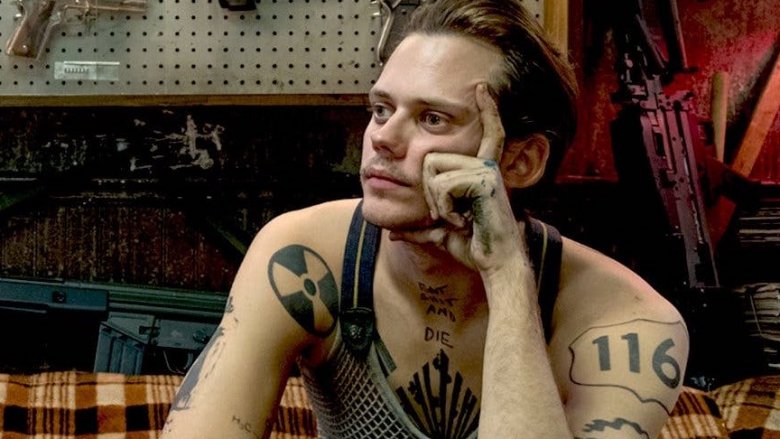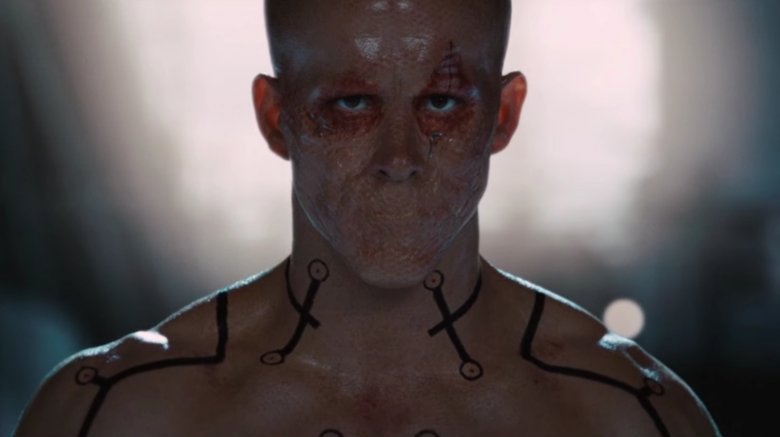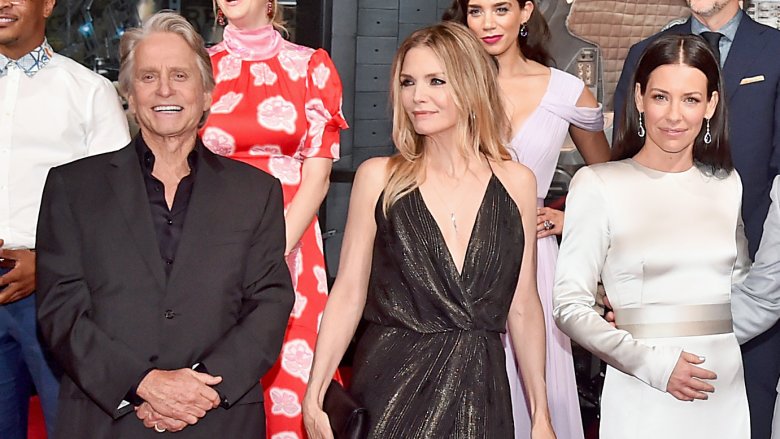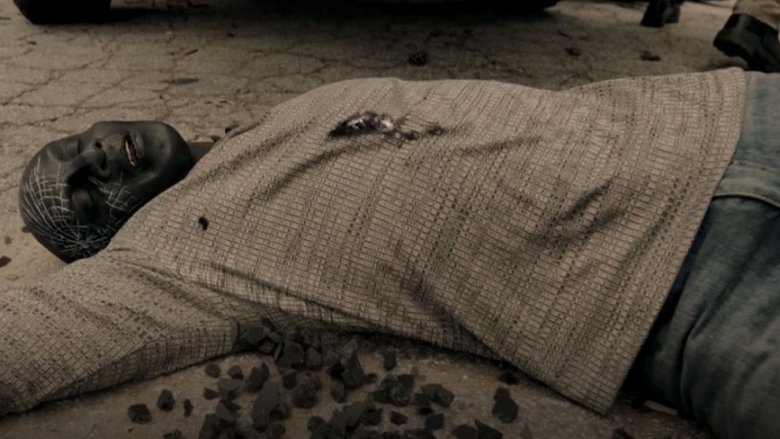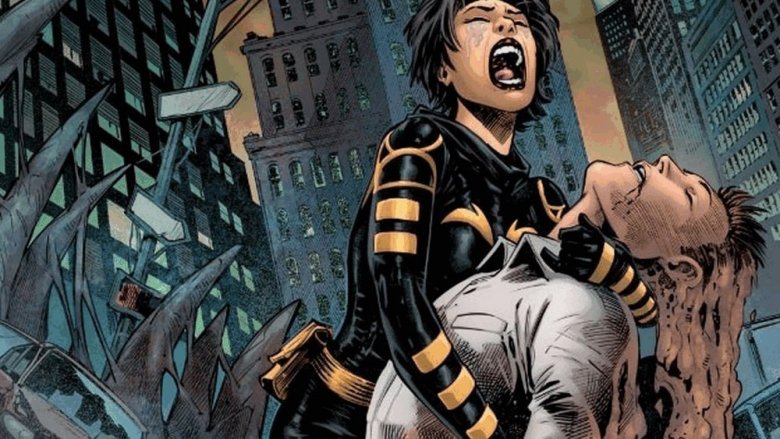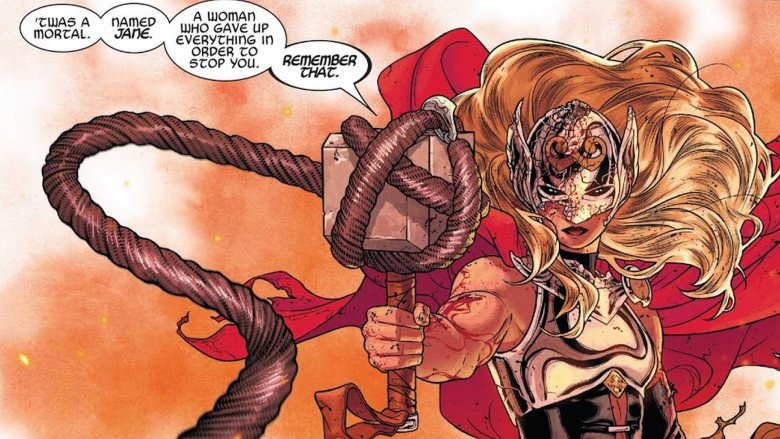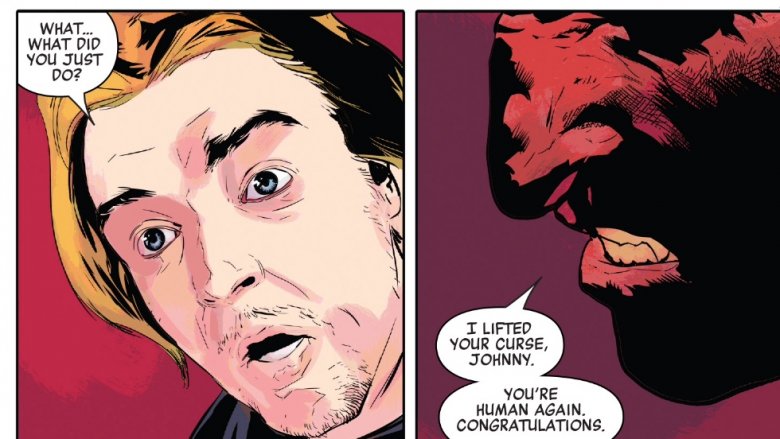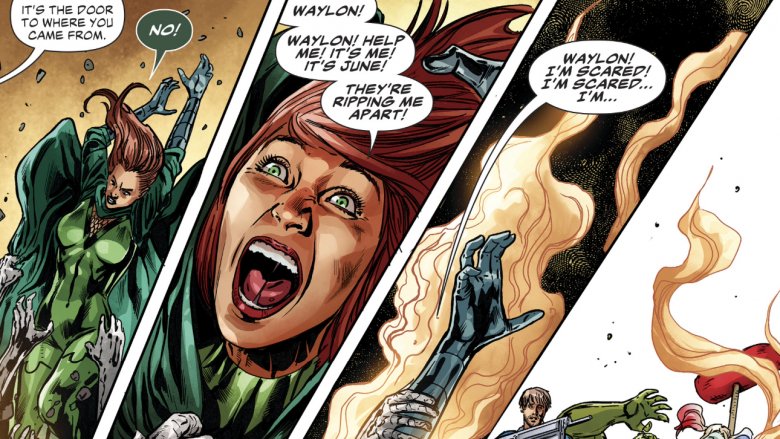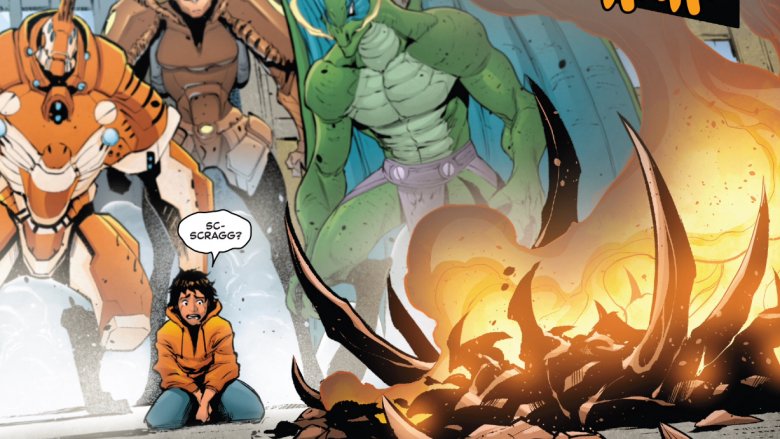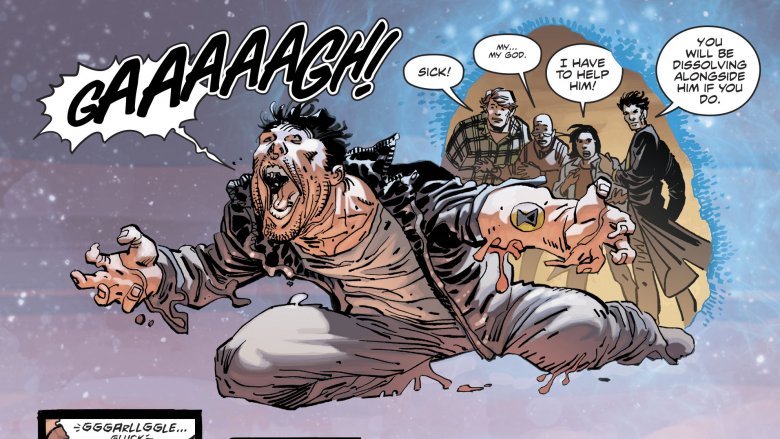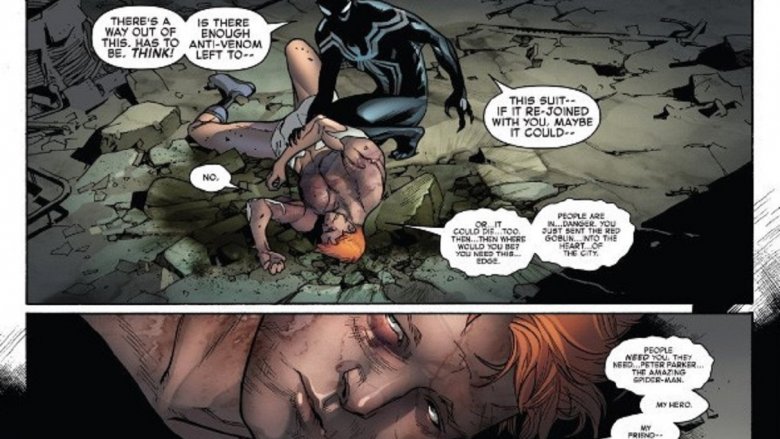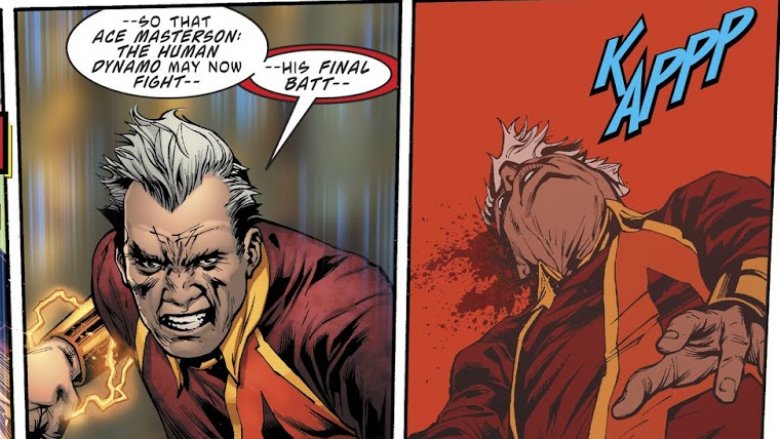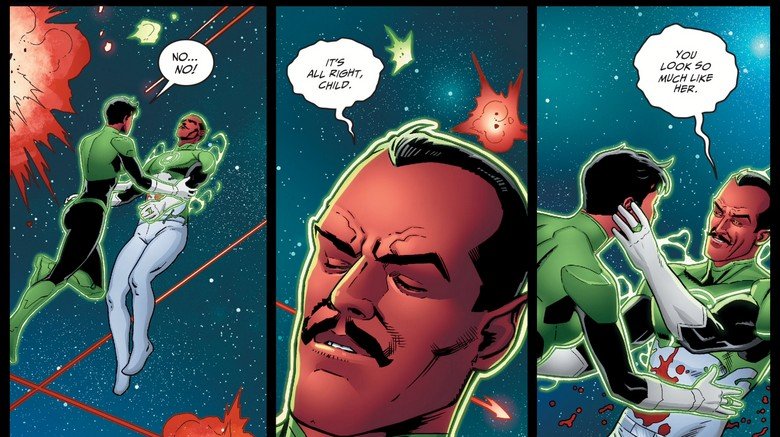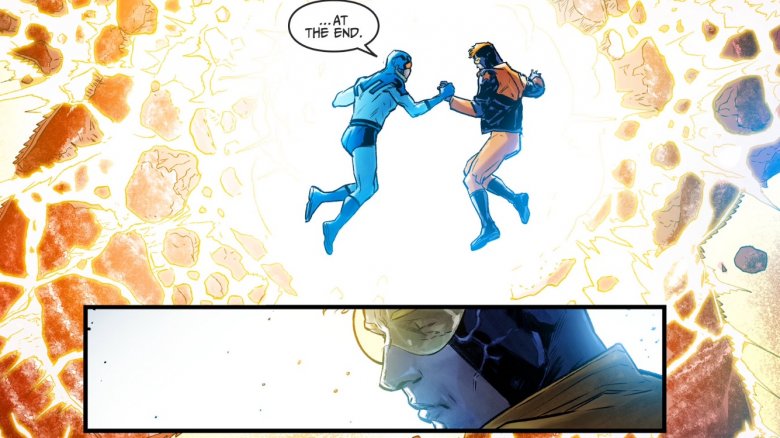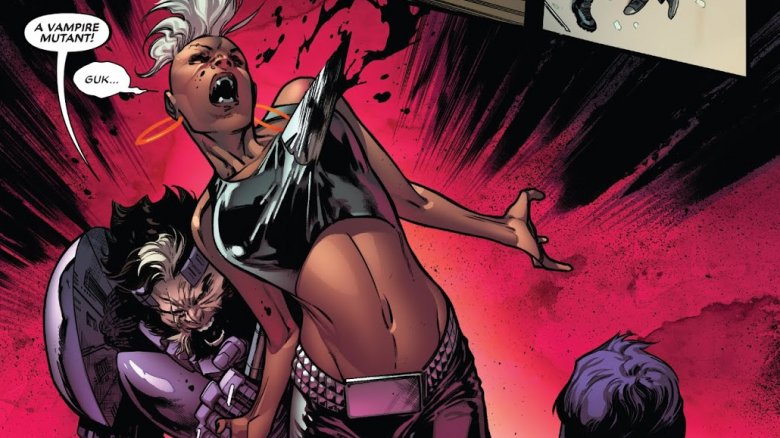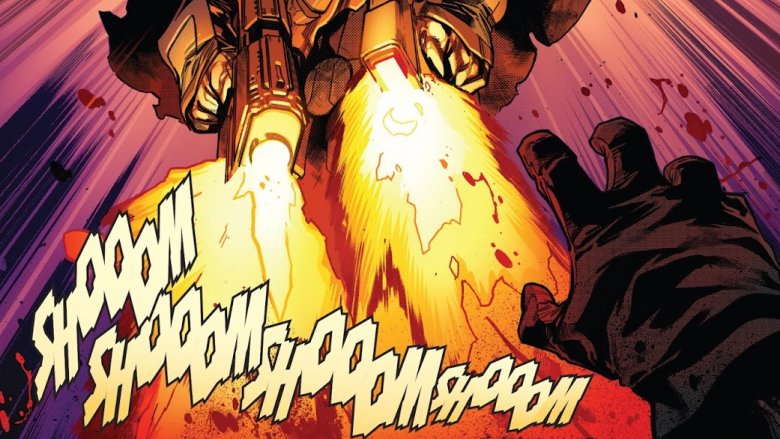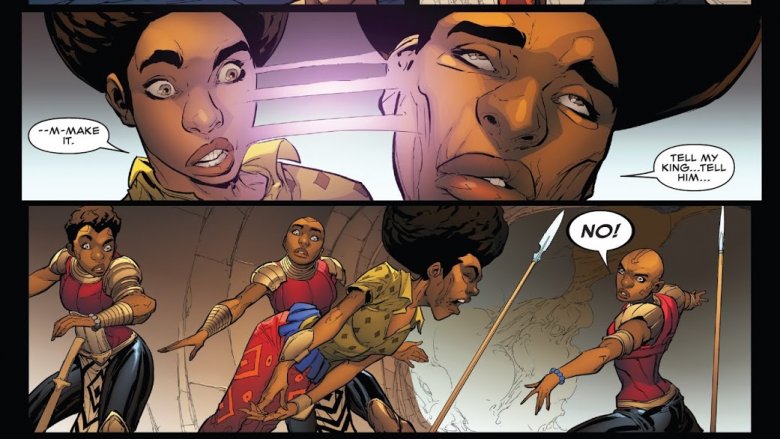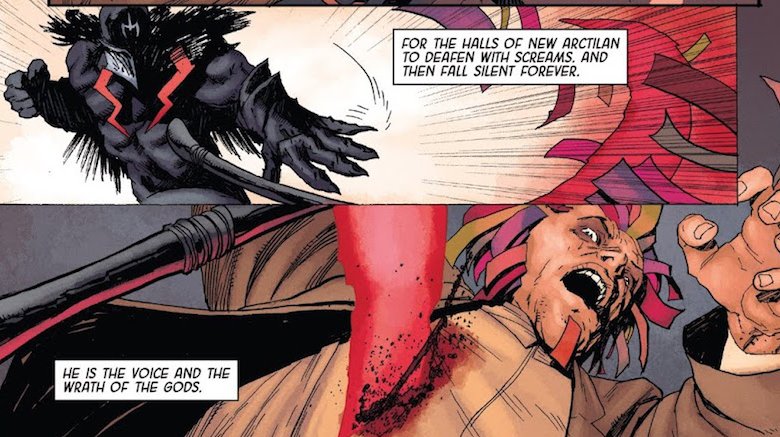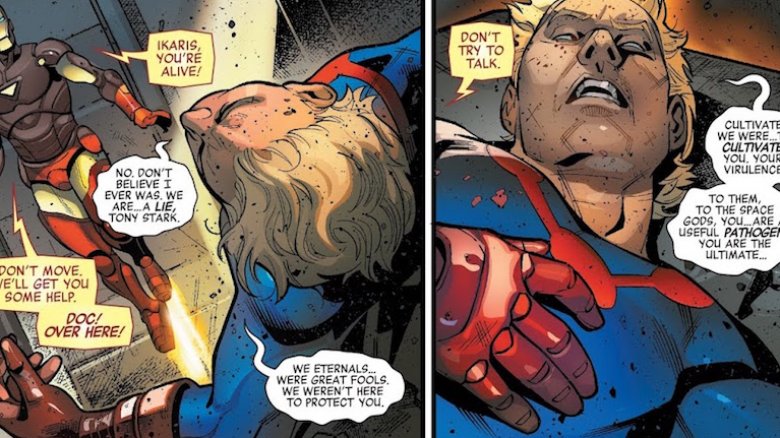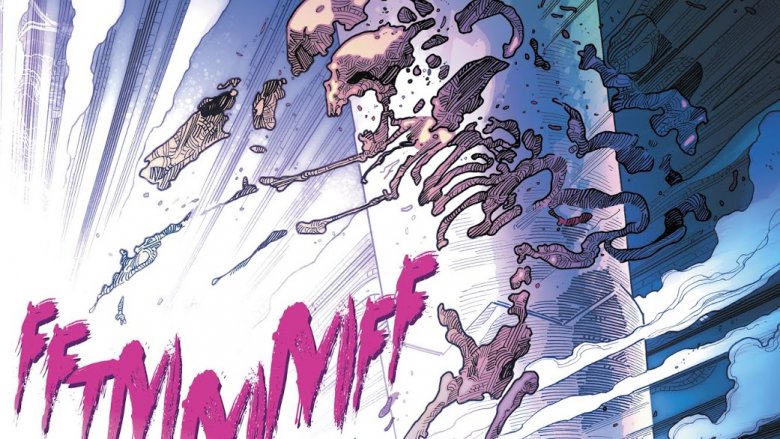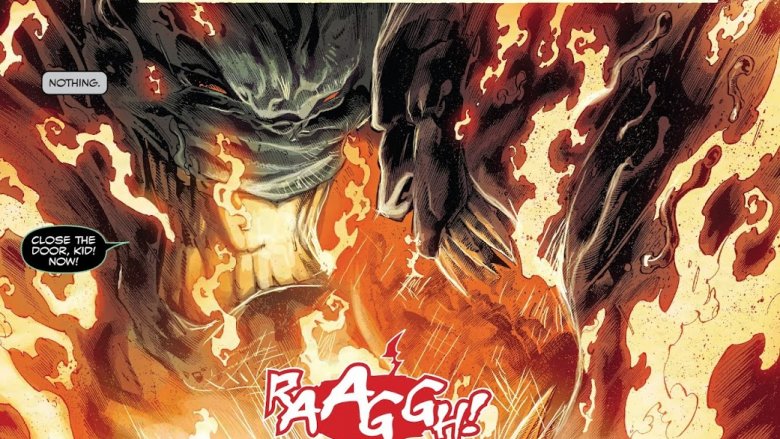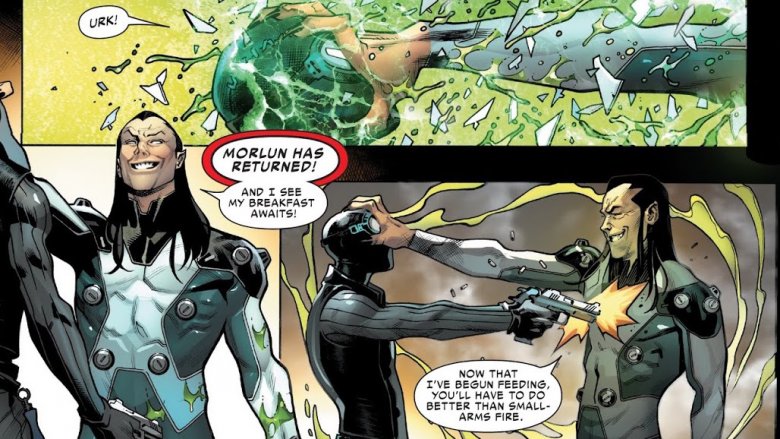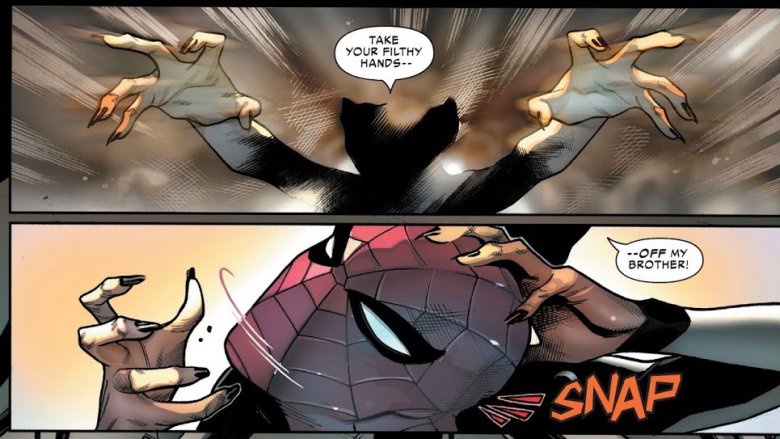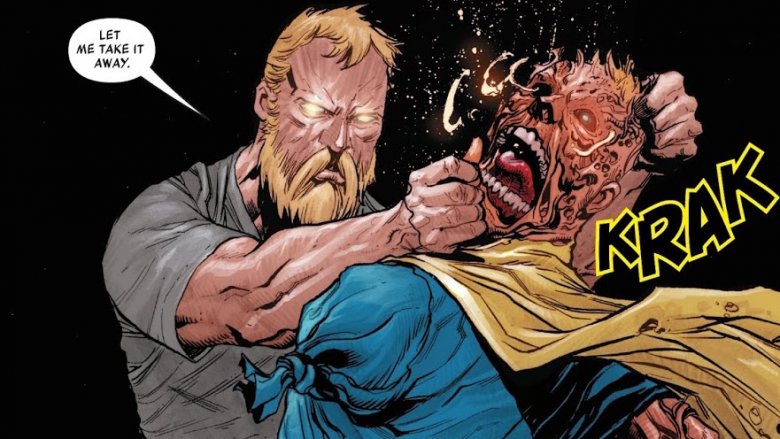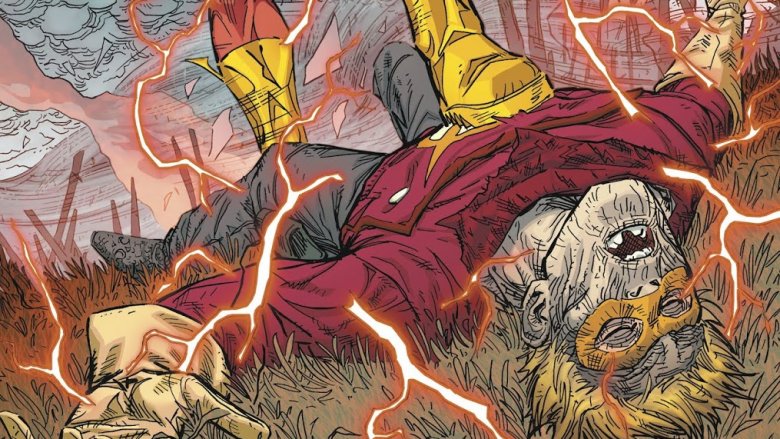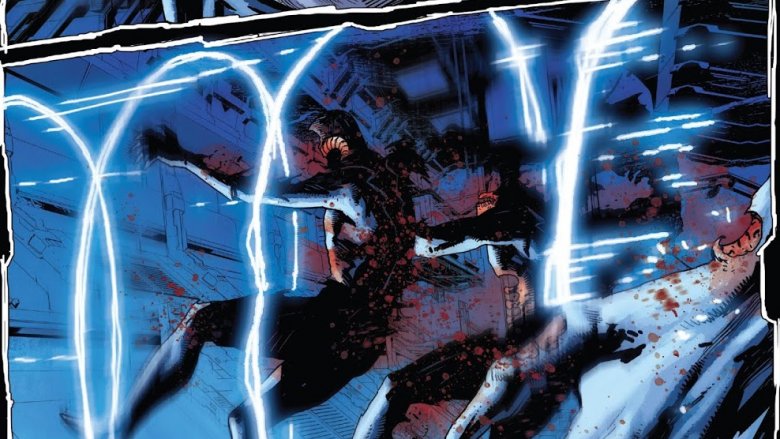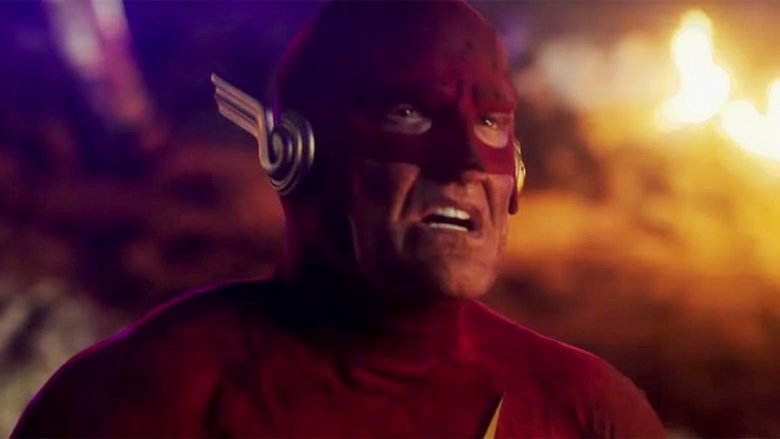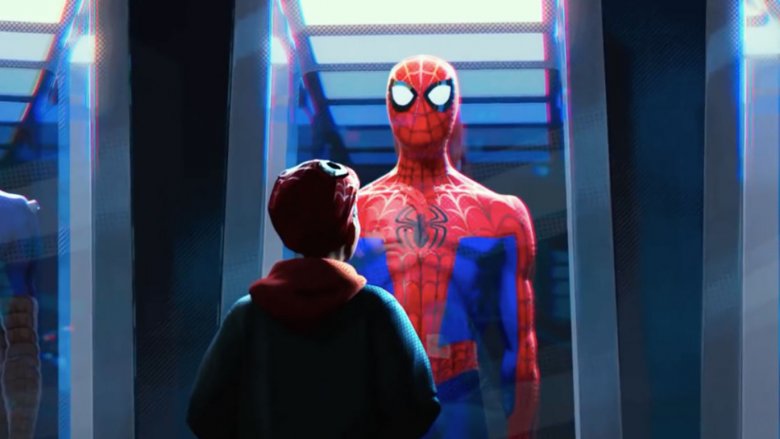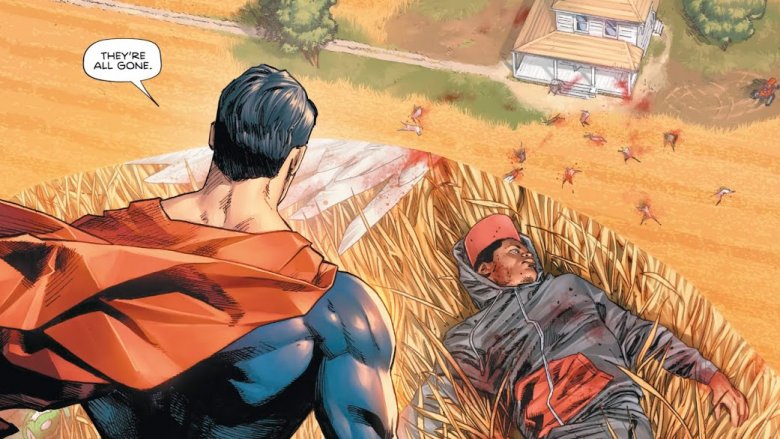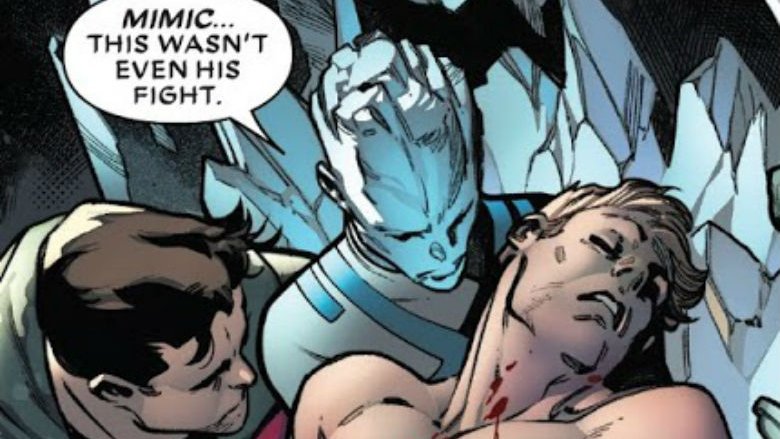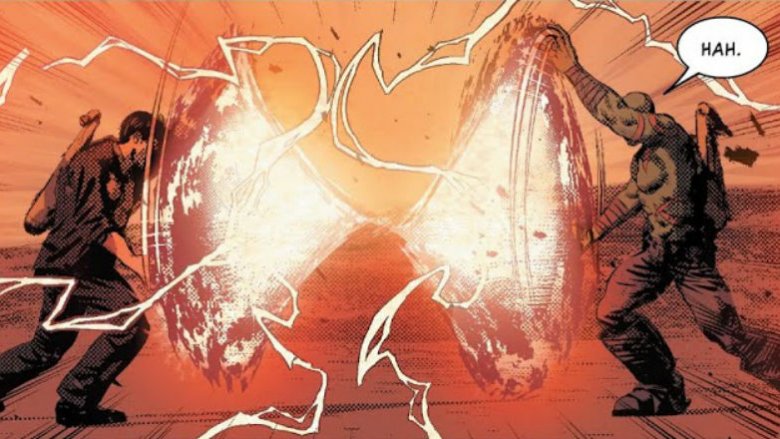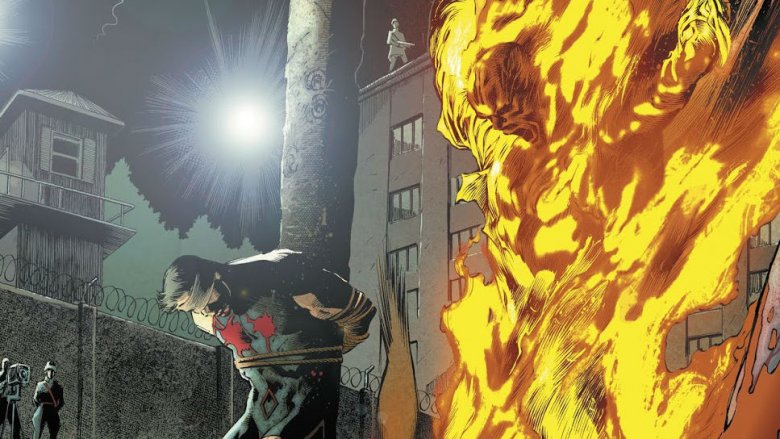Superheroes We Lost In 2018
In spite of the hopes and dreams of James Cameron, it doesn't seem like superheroes will be slowing down any time soon. Superhero movies crowd 2018's film release schedule, not to mention the growing number of superhero television shows, and of course the comics upon which everything else has been based. And with more superhero media comes a higher superhero body count.
Particularly considering the event film Avengers: Infinity War, 2018 promises to be a busy year for anyone betting on a superhero dead pool (like the actual list of people you bet are going to die, not the Marvel superhero named Deadpool). More DC and Marvel shows are coming, Thanos has finally gotten out of that damn chair, and Marvel Comics subtly hinted about one of its heroes' fates by naming a story arc "The Death of the Mighty Thor."
Sure, a lot of them may be back in a couple of years. Or next year. Or next month. Or next week. Or maybe we blinked and they came back without us noticing.
But in the meantime, why don't we honor their loss — or possibly the loss of their clone, their Life Model Decoy, their long-lost twin, or their double from an alternate universe — by remembering the superheroes we've lost so far in 2018.
Rip Hunter (Legends of Tomorrow) April 9, 2018
In the season 3 finale of Legends of Tomorrow, the time-hopping team lost the guy who brought them all together: the former Time Master Rip Hunter (Arthur Darvill).
Earlier in the series, Hunter was discharged from his job at the Time Bureau for his obsession with the demon Mallus. Hunter dies in the season 3 finale attempting to save his friends from that same demon. The hero detonated a time core in order to give the rest of the Legends time to escape Mallus. The explosion killed Hunter, but only weakened his demonic enemy.
Speaking to ComicBook.com about Hunter's death, Legends of Tomorrow showrunner Phil Klemmer said, "I will say that our love for Arthur Darvill exceeds our need for his character...I think he was a reminder of just how far the Legends have come since the premiere."
Hunter wasn't alone in meeting his fate in the season finale. The otherwise nefarious Damien Darhk (Neal McDonough) sacrificed himself to Mallus to save his daughter Nora (Courtney Ford).
Heimdall (Avengers: Infinity War) April 27, 2018
Avengers: Infinity War brought a lot of death to the Marvel Cinematic Universe, claiming a higher superhero body count than any other MCU film to date. As far as named characters go, the first of its victims was one of the last Asgardians: Heimdall (Idris Elba).
Having helped shepherd the surviving Asgardians to safety at the end of Thor: Ragnarok, Heimdall is on board the refugee ship when Thanos and his Black Order attack. When we first see Heimdall, he's already seriously injured, though it's unclear whether this is from the pounding the refugee ship took or from direct battle with Thanos and his followers. Regardless, he's in no position to help Thor, Loki, or the Hulk. At least, not at first.
Presumably counting on Banner warning the other heroes of Thanos' coming, Heimdall uses the last of his strength to activate the Bifrost and send the unconscious Hulk to Earth. "That was a mistake," Thanos tells him — before impaling Heimdall and killing him.
Considering some comments that were attributed to Elba close to the release of Avengers: Age of Ultron, while Marvel fans might miss the Bifrost's guardian, it's possible the feelings might not be mutual.
Loki (Avengers: Infinity War) April 27, 2018
It would be tough to blame anyone for not trusting that Loki's fate was what it appeared to be in the opening of Avengers: Infinity War. Marvel's god of mischief "died" twice already — at the end of Thor and later in Thor: The Dark World – and both times he proved more resilient than his adoptive brother or father assumed. Still, after watching Infinity War, it's difficult to imagine how he could have pulled it off a third time.
After Thanos and the Black Order board the refugee ship, Loki initially seems unwilling to give up the Tesseract. He almost lets Thanos kill Thor rather than hand it over, but apparently the brothers' experiences in Ragnarok awakened Loki's conscience, because he gives in and gives Thanos what he wants, unable to continue watching his brother suffer.
After the Hulk tries and fails to stop Thanos on his own, Loki tricks everyone into thinking he wants to join Thanos in his search for the remaining Infinity Stones. Even Thor is fooled, until he spots one of Loki's daggers. Loki makes a desperate lunge for Thanos, but the Mad Titan is ready for it. He stops Loki's attack easily, grabs him by the throat, lifts him off his feet, and chokes the life out of him.
Considering the hundreds (at least) of innocents who died at Loki's hands in the first Avengers — not to mention the murder of his biological father and the attempted genocide of his own race — it could be argued that Loki's death belongs nowhere near a list of fallen superheroes. However, considering his actions at the end of Thor: Ragnarok and what he tried to accomplish before being killed in Infinity War, while the guy might not have been perfect, he clearly deserves to have been considered more than just a supervillain.
Gamora (Avengers: infinity War) April 27, 2018
Of all the deaths doled out by Thanos in Avengers: Infinity War, the only one that he showed any regret for was the murder of his adoptive daughter Gamora.
Gamora is forced to reveal the location of the Soul Stone to Thanos when he threatens to keep torturing the imprisoned Nebula if she doesn't. Gamora leads Thanos to the planet Vormir, where the two of them are met by the ghostly apparition of the Red Skull.
The Skull explains to Thanos that in order to gain the Soul Stone, he must sacrifice that which he loves most. Gamora laughs at this at first, gloating over what she sees as the Titan's ultimate defeat. Thanos, Gamora believes, loves nothing and no one, so there is nothing for him to sacrifice.
But she's wrong. She realizes it and tries to kill herself before Thanos can, but the Titan uses the Reality Stone to turn her weapon into harmless bubbles. Thanos throws his daughter from a rocky precipice, and we see her still corpse on the ground below before Thanos claims his prize.
Vision (Avengers: Infinity War) April 27, 2018
As a character whose very life presumably depends upon keeping hold of one of the Infinity Stones, the Vision is constantly threatened with death in Avengers: Infinity War. He comes dangerously close to getting taken out the first time the Black Order attacks, but he's saved by the timely intervention of Captain America, Falcon, and Black Widow.
Once he learns of Thanos' plans, Vision insists the only choice is to let Scarlet Witch use her powers to destroy the Mind Stone. Bruce Banner believes there's a way to do it without killing Vision, but that he doesn't have the expertise or the technology to do the job. So the team heads to Wakanda, where T'Challa's sister Shuri gets to work on saving the Vision and the universe.
Ultimately, everyone's efforts and debates about whether or not Vision should have to sacrifice himself for the good of many prove fruitless. Thanos arrives in Wakanda with every other Infinity Stone under his command. Scarlet Witch destroys the Mind Stone, killing Vision in the process, but Thanos uses the powers of the Time Stone to put Vision and the Mind Stone back together (just as Stephen Strange was able to use it in Doctor Strange to un-destroy Hong Kong and its Sanctum). Thanos rips the stone from Vision's head, caving in the android's skull. Vision's body turns grey and he falls to the ground, presumably lifeless.
Interestingly, a similar — but not identical — fate recently befell Vision in the comics. In Avengers #685, the freshly resurrected Hulk crushed the solar gem embedded in the Vision's forehead, crippling him. The gem was not an Infinity Stone and the Vision of the comics didn't die, but it was clearly traumatic. Immediately afterwards, Vision was left helpless, repeating zeroes and ones over and over. Five issues later, in Avengers #690, his teammates were still trying to reactivate him.
The dusty deaths of the Avengers? (Avengers: Infinity War) April 27, 2018
Avengers: Infinity War ended with a cliffhanger so dark, it made Empire Strikes Back say, "Dude. Lighten up."
One of the comics that heavily influenced Avengers: Infinity War was the 1991 miniseries and line-wide Marvel Comics event Infinity Gauntlet. In the source material, the story begins when Thanos gathers all six Infinity Stones and, with a snap of his fingers, kills half the sentient beings in the universe — including half the population of Earth and a huge chunk of its superhero ranks.
Avengers: Infinity War saves this moment for the conclusion to the film, and it's devastating not only for the civilian populace of the universe, but the ranks of the Avengers and their allies. The Russo brothers' portrayal of the event is much more horrific than the source material. In the comics, people just blinked out of existence. In Infinity War, they feel what's coming before it hits, and they're slowly erased — inch by inch — until there's nothing left.
By the time the credits roll we watch Bucky, Falcon, Scarlet Witch, Black Panther, Spider-Man, Groot, Star-Lord, Drax, Mantis, and Doctor Strange all get erased from the canvas of reality. In the film's one and only post-credits scene, we see similar fates befall Maria Hill and Nick Fury.
Considering that there are already confirmed sequels in the works for Guardians of the Galaxy, Black Panther, and Spider-Man: Homecoming, it's a safe bet that not all of these dusty deaths will stick. But if they do get reversed, it likely won't be until next year's Avengers sequel — and we won't know until then who will come back and who won't.
Bedlam (Deadpool 2) May 18, 2018
If there were an Oscar for misleading trailers, Deadpool 2 would be bringing home at least one statue this year.
In spite of being featured in at least one action scene in the Deadpool 2 trailers, Bedlam (Terry Crews) was the first of Wade Wilson's X-Force to kick the bucket, and he did it before he got to do so much as swing a fist.
With Weasel's help, Deadpool threw together X-Force in order to spring the teenager Russell from prison and protect him from the vengeful, time-hopping Cable. During an air drop to a prisoner transport convoy, high-speed winds blew the whole team off course and — save for Deadpool and Domino — the entire roster of X-Force ended up being killed. Bedlam was blown face-first into the windshield of a public bus. Deadpool slammed into a sign soon afterward, and eventually found Bedlam's lifeless body still hanging from the vehicle.
There was no word on whether or not Bedlam had used Old Spice that morning, and if so, why he didn't survive.
Shatterstar (Deadpool 2) May 18, 2018
In the darkly hilarious carnage that followed the prison transport convoy air drop, the X-Force member's death who likely surprised fans the most was that of Shatterstar. Like Bedlam, the trailers featured the alien warrior in an action scene, making it that much more of a surprise that he didn't survive long enough to draw his swords and prove to Deadpool how much better he was at everything.
The high-speed winds that spelled the end of of Deadpool's first shot at X-Force blew Shatterstar into the spinning blades of a helicopter. And in case there was any doubt about the his otherworldly origins, after hitting the helicopter blades, the resulting gore was bright green.
Of course, Shatterstar's origins could possibly give him an out. He told Deadpool and Weasel he's from Mojoworld, but what he didn't tell them — assuming his origin is the same as that of the comics — is that Mojoworld exists one century in the future. So with time travel already in the mix and confusing things, maybe you could say that even though that Shatterstar got turned into cucumber juice, there's another Shatterstar on Mojoworld who never went to Earth and so — no, he's cucumber juice.
The Vanisher (Deadpool 2) May 18, 2018
When the Vanisher was first mentioned in the X-Force recruitment scene, no one was really sure the guy existed. It wasn't until the air drop began and audiences saw a parachute pack bobbing up and down — and eventually following the rest of the team — that we learned there actually was a team member named Vanisher. Still, it wasn't until X-Force members started making like Marines in a James Cameron movie that we found out who had been cast as Vanisher. As his parachute strayed into electrical wires, we saw the mutant become visible just as he was being electrocuted, and the unmistakable face of Brad Pitt filled the screen.
The Vanisher of the comics, by the way, is neither an X-Force member nor does he have invisibility powers. Vanisher is one of the X-Men's earliest villains, whose sole power was that of teleportation, minus the blue stinky clouds Nightcrawler leaves behind.
Still, source-material-correct or not, that was pretty freaking funny.
Zeitgeist (Deadpool 2) May 18, 2018
Zeitgeist, the guy with the super power so gross Deadpool and Weasel refused to see it before recruiting the guy, was one of the last X-Force members to die in the infamous air drop. Perhaps in tribute to the fact that, at least in this role, actor Bill Skarsgård looks a bit like Steve Buscemi, Zeitgeist suffered perhaps the most gruesome death of all — getting sucked into the wood chipper.
The only time we see Zeitgeist use his incredibly disgusting super power is as he dies. Utterly powerless X-Force teammate Peter grabs onto Zeitgeist and tries to pull him out of the wood chipper, but the almost dead Zeitgeist involuntarily barfs his acid all over Peter, killing him.
Peter was lucky enough to be saved by Deadpool with Cable's time machine in the mid-credits sequence — though that same sequence didn't show Deadpool preventing the deaths of anyone else in X-Force.
Movie Deadpool version 1.0 (Deadpool 2) May 18, 2018
When Deadpool uses Cable's time machine to undo Vanessa and Peter's deaths in the mid-credits sequence of Deadpool 2, he also uses it to correct some more notorious mistakes.
X-Men Origins: Wolverine is often maligned for, among many other things, Ryan Reynolds' ridiculous (and not in a good way) depiction of that movie's Wade Wilson, who ultimately turns into a mouthless, murderous freak who looks like a character who might belong in Mortal Kombat. As much as you may hate X-Men Origins: Wolverine, Ryan Reynolds hates it more (he had to be in it, after all). And he proved it in the mid-credits sequence of Deadpool 2 when he used Cable's time travel device to go back in time and kill this earlier, deeply flawed version of himself. He does it thoroughly, apologizing to Wolverine as he fires bullet after bullet into the already lifeless husk.
Hank Pym, Hope van Dyne, and Janet van Dyne (Ant-Man & The Wasp) July 6, 2018
While most of Ant-Man and the Wasp takes place before the events of Avengers: Infinity War, the mid- and post-credits scenes caught up to the Avengers' battle with Thanos — and showed us that the original Ant-Man and both women who went by the codename Wasp were victims of Thanos' infamous "snap."
Ant-Man and the Wasp's mid-credits scene shows Scott Lang, Hope, Hank, and Janet together on a rooftop. Equipped with a canister to capture quantum energy meant to help with Ava's recovery from her phasing condition, Scott Lang re-enters the Quantum Realm. Hope, Hank, and Janet monitor the controls while Scott collects the energy and everything seems to be fine, but once he's ready to reeled back in, no one's answering. At first Lang thinks his colleagues are messing with him, but when the camera cuts back to the rooftop, Pym and the Van Dyne women are gone, replaced with dusty ashes floating slowly to the rooftop — presumably the same ashes we saw at the end of Avengers: Infinity War.
The makers of Avengers 4 have made it clear that we won't see all the dead heroes of Infinity War return, and it's possible that we can add the fallen heroes of Ant-Man and the Wasp to the list. Whatever the fate of Pym and the Van Dynes, we'll have to wait until 2019 to find out.
Shatter (The Gifted) November 6, 2018
Before now we've seen some of the ugliness of the anti-mutant hate group the Purifiers, but mostly in flashbacks, and their actions don't usually go as far as killing. That changed with the Nov. 6 episode of Fox's The Gifted — "iMprint" — when the mutant Shatter (Jermaine Rivers) died trying to save his friends in the Mutant Underground from a Purifier assault. Shatter has been absent for most of the second season, but appeared regularly in the first.
In the previous episode, disgraced Sentinel Agent Jace Turner (Coby Bell) flirted with the notion of joining up with the Purifiers. In "iMprint," Turner joins the Purifiers while seeming intent on changing their methods. He leads a group of Purifiers in a raid of a mutant-friendly clinic and finds intel pointing to the Mutant Underground's base. Armed with mostly small arms and some smoke grenades, the Purifiers surrounded the Mutant Underground's base.
Shatter volunteered to distract the Purifiers while Reed (Stephen Moyer), Eclipse (Sean Teale), Thunderbird (Blair Crawford), and others could escape. Most of the Purifier's weapons couldn't pierce Shatter's skin, and one died fighting the mutant off. But former agent Turner brought heavier ordinance. Clearly conflicted but ultimately resolved to his course, Turner fired a heavy machine gun at Shatter, piercing the mutant's chest and killing him.
The Shatter of the comics first appeared as one of the subway-tunnel-dwelling Morlocks. He lost his powers as part of the 2005 Marvel Comics Event House of M.
Clayface (Detective Comics #973) January 24, 2018
It might not make sense at first to see the name of one of Batman's signature villains on a list of fallen superheroes, but Basil Karlo had recently taken steps to change his ways and make up for the wrongs he'd perpetrated in the pages of Detective Comics. He'd gone so far as to be recruited by Batman — a hero not known for naïveté or for giving former enemies the benefit of the doubt — into the ranks of the Gotham Knights. Unfortunately, that recruitment ultimately led to Clayface's death and the disbanding of the Knights.
Toward the end of the Fall of the Batmen storyline Clayface went wild and smashed through Gotham, destroying everything in his path. While most of the team tried to find a nonlethal way to stop their teammate's rampage, Batwoman was given a gun designed to kill Clayface by her father Colonel Kane. When she told her father Batman would never allow the use of such a weapon, he suggested perhaps it could be altered to simply incapacitate him.
Detective Comics #973 ended with Batwoman blasting Basil Karlo through the skull with her father's gun. Colonel Kane's suggestion led some to hope that the dramatic final page was just a cliffhanger and Batwoman had simply rendered Clayface helpless without killing him. Unfortunately, Dr. October confirmed Clayface's death in the following issue. Enraged, Batman ejected Batwoman from the Gotham Knights.
The Mighty Thor and Mjolnir (Mighty Thor #705) March 21, 2018
Marvel Comics has gotten a lot of press over the last couple of years for drastically changing the status quo of some its marquee characters. One of the changes that lasted the longest — and left the biggest mark — was Thor being replaced by a woman. The Odinson lost his "worthiness" during the 2014 Marvel line-wide event Original Sin, and was forced to leave Mjolnir on Earth's moon. For a time it was a mystery who subsequently lifted the hammer and claimed the thunder god's powers. Soon enough, fans learned it was Thor's former lover, Jane Foster.
Foster was suffering from cancer when she took up Mjolnir. Eventually she learned living as Thor was killing her. Every time she transformed into Thor, she undid all of her chemotherapy treatment. As more people in her life learned of this, they grew more adamant that she stop turning into Thor and let the rest of the world's heroes do the heavy lifting.
When the Mangog was unleashed on Asgardia, at first Foster listened to her loved ones' advice. But it soon became clear that without Thor and Mjolnir, Mangog would finally achieve his hellish goal of killing all of the Asgardian gods.
In Mighty Thor #705, Thor used the unbreakable chains that once held the wolf Fenris prisoner, wrapped them about Mjolnir and Mangog, and hurled the both of them into the Sun. Mjolnir was destroyed, and Mangog was forever imprisoned (for now). Without Mjolnir, Thor reverted back to Jane Foster and died.
Jane Foster would survive. When Mjolnir was destroyed, it released the Mother of All Storms that resided within it; Odin and the Odinson (the original Thor) channeled the storm into Foster and brought her back to life. But the Mighty Thor — the Jane Foster Thor — was dead, along with Mjolnir.
Ghost Rider/Johnny Blaze (Doctor Strange: Damnation #3) March 21, 2018
Usually when it's called a "suicide mission," it means probably no one on the mission wants to die, but the odds are so stacked that there's almost now way anyone's going to make it.
In the case of Johnny Blaze's suicide mission, the death wasn't an unfortunate side effect — it was the whole point of the thing.
Johnny Blaze died during Marvel's mini-event, Damnation. When Doctor Strange used his magic to foolishly try to restore the city of Las Vegas — after the destruction it suffered in Secret Empire – Mephisto used the opportunity to come to Earth and start turning Marvel's Earth into a new Hell. While Strange fought in Las Vegas, Wong hobbled together a makeshift Midnight Sons team-up that included Johnny Blaze, Marvel's original supernatural Ghost Rider.
In Doctor Strange: Damnation #3, Blaze found Mephisto's throne atop a very Sauron's-Black-Tower looking spire. Unimpressed with his old enemy's bravado, Mephisto snuffed out the flame of Johnny's skull as if he were blowing out a candle, lifting the Ghost Rider curse from him. Then, with Blaze's powers gone, Mephisto kicked Johnny from the spire. Blaze fell to the ground far below and died.
But, as readers learned in Damnation: Johnny Blaze — Ghost Rider #1, having Mephisto kill Johnny Blaze was the plan the whole time. After he died, Blaze and his "dark passenger" the Ghost Rider awoke in Hell. Gathering some recruits, including an assortment of dead D-list supervillains, Blaze and Ghost Rider joined forces and staged a revolution. With Mephisto in Las Vegas, his throne in Hell was empty, and Blaze was able to use the power of Hell to help Strange and his other allies.
Wong and Strange have vowed to get Blaze back from Hell. In fact, Doctor Strange: Damnation #4 — the climax of Damnation — ends with Strange proposing a team he wants to put together for the job. However, considering Marvel's commitment to keeping the newest Ghost Rider — Robbie Reyes — around, it may be that Strange and co. won't be able to get their friend back.
Enchantress (Suicide Squad #39) April 11, 2018
While the Enchantress of the film Suicide Squad wound up being the team's Big Bad, the Enchantress of the comics has been a loyal team member (well, as loyal as a Suicide Squad member ever could be) since the title's relaunch during DC's 2016 Rebirth event. She'd even struck up what must have been a physically...interesting romantic relationship with teammate Waylon Jones, a.k.a. Killer Croc. That ended with Suicide Squad #39 and Enchantress' death.
The Squad faced off against the Wall, an ultraviolent patriotic-themed villain sponsored by the U.S. government. Rick Flagg scooped Enchantress out of the prison Belle Reve for extra muscle against the Wall, but the red-white-and-blue bad guy was ready for her.
When the Squad confronted the Wall, he revealed he'd been remotely downloading files from the government, including Amanda Waller's files on the Squad. One of those files included a way to kill The Enchantress: a 3-D digital reproduction of a mystical key to Hell. What appeared to be cement arms rose from the pavement and dragged Enchantress below, presumably back to the Hell she came from. June Moone — Enchantress' human half — resurfaced and cried to Killer Croc for help, but he and the rest of the Squad had been knocked off their feet by the summoning.
Unsurprisingly, Killer Croc gave the Wall a savage beating immediately afterwards, but the villain was able to fight off the Squad and escape.
The Mighty Scragg (Venomized #5) May 2, 2018
Marvel writer Cullen Bunn has been at the head of a series of mini-events focusing on the anti-hero Venom beginning with 2017's Venomverse. Last year's event introduced an alien race known as the Poisons who were scouring Marvel's multiverse for heroes who had merged with Klyntarian hosts like Eddie Brock because the symbiotes were particularly vulnerable to the Poisons. The villains of Venomverse were thwarted by a team of heroes from different realities who were merged with Klyntari symbiotes. The Poisons survived and they hit Earth-616 — Earth Prime of the Marvel Universe — in Venomized.
One of the Poisons' primary targets in Venomized was Kid Kaiju: the young Inhuman of Monsters Unleashed with the power to summon and communicate with monsters. Though he was warned to stay away from the conflict, Kid Kaiju joined the band of heroes battling the Poisons in New York City. Unfortunately, not all of his monstrous buddies survived the battle.
Kid Kaiju's monsters joined him in NYC, including Scragg — an insectoid giant known to refer to himself as "The Mighty Scragg." The hero Anti-Venom and Slizzik (another of Kid Kaiju's monsters) were forced to kill Scragg at the end of the fight. The Poisons infected Scragg and he promptly switched sides and attacked the heroes. The heroes tried to stop him without killing him, but he was too powerful. Anti-Venom — whose powers had earlier proven fatal to any Poisons as well as their hosts — insisted he had no choice but to use his powers on Scragg. Anti-Venom's touch immediately caused Scragg excruciating pain, and Slizzik finished off Scragg with a blast of fiery breath.
Before his death, Scragg managed to exert enough control to tell Kid Kaiju he loved him.
Robert Brink (New Challengers #1) May 16, 2018
One of the DC titles considered part of the fallout of the line-wide event Dark Knights: Metal, the six-part miniseries New Challengers is a reimagining of the early Silver Age group the Challengers of the Unknown. Unlike earlier incarnations of the characters, the quartet in this series are essentially prisoners. Trina Alvarez, Moses Barber, Robert Brink, and a big guy who refuses to be known as anything other than "Krunch" all appear before their mysterious benefactor — who calls himself Prof — and are told they have all just died. Each of the Challengers bears an hourglass tattoo, and just as Prof is explaining that nature of that tattoo, one of the Challengers dies before he can go on his first mission.
Robert Brink, a Spyral operative, steps into a portal without looking back or waiting for Prof to explain what will happen to Brink if he leaves. As soon as Brink is on the other side of the portal, he screams and his body dissolves, as if he were literally melting. As Brink dies, Prof tells the other Challengers that he tried to warn the melting hero about what would happen if he left before he was done "coalescing" and that the same will happen to them if they try to follow Brink through the portal. Whenever the Challengers leave their base of operations known only as "The Mountain," they're on borrowed time. They'll share Brink's fate if they're ever gone for too long.
Seconds after Brink's death, a portal opens and deposits his replacement — Bethany Hopkins – among the group. A frozen hologram bearing Brink's likeness appears among those of other dead Challengers.
Flash Thompson, a.k.a. Anti-Venom (Amazing Spider-Man #800) May 30, 2018
The 80-page Amazing Spider-Man #800 brought fans the climactic battle between Spider-Man and the Red Goblin — the joining of the symbiote Carnage with Norman Osborn (a.k.a, the Green Goblin). But Spidey wasn't alone, and one of his oldest friends, Flash Thompson, fell victim in the fray.
Osborn waged war on Peter Parker the way he always had — by going after Parker's friends and loved ones like Mary Jane and Aunt May. Former enemies like Venom and Otto Octavius threw themselves between Carnage and his prey. Weakened, Eddie Brock loaned his symbiote to Spider-Man, who went after the Goblin on his own. Osborn then revealed the deadly ace up his sleeve: he'd left tiny, dagger-like slivers from his symbiote in each of Parker's friends that he could manipulate with his mind. He tried to activate them, but couldn't — and that's when Thompson, a.k.a. Anti-Venom, appeared and revealed he'd used his own symbiote abilities to sense and remove the daggers from all of Spider-Man's friends before Goblin could activate them. Osborn's retribution on Thompson was swift and brutal.
Spidey threatened to go full Venom, fueled by his rage and grief, but the dying Flash was able to stop him. Spidey offered to give the symbiote to Thompson, but he refused, worried his wounds would kill it. Fatally injured, Thompson died, eulogized by Parker at the end of the issue.
The Human Dynamo (Deathstroke #32) June 6, 2018
Slade Wilson is at war with Batman. In Deathstroke #32, Batman tries to stop Wilson from assassinating his latest mark, an obscure hero named Ace Masterson: The Human Dynamo. Deathstroke succeeds in killing Masterson, mainly because it's Masterson who hired him.
At the height of Deathstroke's battle with Batman, Masterson blasts them apart and tells his story. In the '60s, he was one of a small group of heroes named the Justice Experience. Unfortunately, Masterson was the only member of the group to survive its first mission. Decades later, he's learned that while his powers are keeping him alive, he's still aging. More importantly, he's beginning to experience dementia, and he worries what might happen to the world if someone with his power were to become too confused. Rather than find out, he's chosen to hire Deathstroke to help him go out in a blaze of glory.
Unconvinced, Batman tries to teleport Dynamo to the Justice League satellite, but Dynamo uses his powers to stop the transport. Finally given an opening free of Batman's interference, Deathstroke shoots Masterson in the head, killing him.
Though obscure, this was not the first mention of the Justice Experience. They were created for the 1998 series Chase and used to bridge the time gap between the end of the Justice Society of America and the coming of the JLA. Most of them were murdered as well, though it turned out one member — the Bronze Wraith — was J'onn J'onzz (a.k.a. Martian Manhunter) in disguise.
Sinestro (Injustice 2 #64) June 26, 2018
Sinestro isn't often aligned with the good guys, but in DC's ongoing Injustice narrative, the former villain rejoined the Green Lantern Corps in time to fall protecting Oa in Injustice 2 #64.
Atrocitus assaulted the home planet of the Green Lantern Corps with Starro-spore possessed Green Lanterns — including one of the Guardians — as well as his own army of rage-fueled Red Lanterns. Sinestro's daughter Soranik was one of the possessed Green Lanterns and moved to attack the Teen Titans. Sinestro intercepted his daughter, so she drove a spear of green light through his torso. Using the last of his strength, Sinestro ripped the Starro spore off his daughter's face, freeing her from Atrocitus' control. The redeemed Lantern used his dying breaths to admit that it was his fault Soranik's mother committed suicide. As Sinestro's words faded, his ring slipped from his finger, confirming his death and looking for a replacement. It landed in Soranik's palm, saying "Replacement already active."
Booster Gold (Injustice 2 #66) July 10, 2018
Injustice 2 #66 claimed another hero's life in its cosmic war. Two issues ago, Sinestro fell to his daughter who was being mind-controlled by Starro. This time, Booster Gold and Blue Beetle were finally able to bring an end to Starro, but at the cost of Booster Gold's life.
Beetle's Scarab showed him a scene from the distant past, of another Blue Beetle defeating Starro — but the woman in the vision had to sacrifice herself to do it. The current Blue Beetle tried to do the same thing once he and Booster reached Starro, but once Booster realized what Beetle was doing, he put his own breathing mask on Blue Beetle and instructed his little robot buddy Skeets to get the younger hero out of there.
Just before his death, Booster was visited by Ted Kord — the Blue Beetle who died earlier in the series. A time-traveling version of Booster Gold brought Kord there so his best friend could be with him in his final moments.
Bloodstorm (Extermination #1) August 15, 2018
Marvel's Extermination event opened with a lot of bloodletting, and the first victim's name was more than apt. Bloodstorm — a vampiric alternate reality version of Storm — was the first X-Men member to fall.
Bloodstorm and the young Cyclops were out on a first date when the mutant hunter Ahab and a pair of his enslaved hounds smashed into the restaurant, apparently intent on kidnapping Cyclops. Bloodstorm fought one of the hounds off Scott, and Ahab speared her through the back and chest with his harpoon, killing her. Afterwards, Ahab revealed he'd encountered vampire mutants before and treated his harpoon with silver just in case he met another. Ahab and his hounds escaped before Cyclops could contact the rest of the X-Men.
Bloodstorm first showed up in 1998's Mutant X as part of an alternate reality team of X-Men, and quickly became the most popular member of the team; on the letters page of Mutant X #7, editors told readers that most of the fan mail they'd received focused on her. The character popped up every now and then over the years, and eventually arrived in the prime Marvel reality and subsequently joined Earth-616's X-Men in X-Men: Blue.
Cable (Extermination #1) August 15, 2018
Cable was the second to fall in Extermination, and his death came at the hands of a fellow time traveler.
Extermination #1 begins with a mysterious hooded figure surveying a recently destroyed Xavier's Institute 20 years in the future. After talking to himself and saying he's going to have to "clean up" an "old bastard's" mess, he disappears in a bright flash of light.
Later, after Bloodstorm's death, the young Iceman is hurrying back to Xavier's Institute. An unseen assailant attacks Iceman, driving him into a clothing store. Cable appears out of the blue, urging Iceman to run. Iceman refuses and is tagged with some kind of dart emitting energy that incapacitates him. The hooded figure appears, overcomes Cable, and executes him – telling him he's "relieved of duty." When the rest of the X-Men appear and find Cable's body, Iceman is nowhere to be seen and none of the team's psychics can locate him.
The issue ends with the revelation that the hooded figure was a much younger and leaner version of Cable. We see him in a chamber with five stasis pods, one of which holds the young Iceman. A nearby screen shows the faces of all five of the original X-Men that Beast brought to the present in 2012's All-New X-Men, with a red X through Iceman's face. The young Iceman is presumably alive (otherwise, why bother with a stasis pod?), but there's no way just yet to know what fate young Cable has in mind for Iceman and his teammates.
Nakia, a.k.a. Malice (Wakanda Forever: Avengers #1) August 22, 2018
Marvel's mini-event Wakanda Forever ended with the death of Nakia. Fans of the MCU may remember Nakia as T'Challa's love interest — portrayed by Lupita Nyong'o — in 2017's Black Panther, though the character's story is quite different in the comics.
Nakia was one of the first of the Dora Milaje that readers met in 1998's Black Panther #1. Two issues later, the devil-like Mephisto subjected T'Challa to hallucinations that tricked him into kissing Nakia. Refusing to acknowledge the dark magic that forced the kiss, Nakia became obsessed with T'Challa and eventually left the Dora Milaje's service. She imbibed a herb called Jufeiro to render herself irresistible to men and she became the villain Malice, dedicated to do whatever she had to, and kill whoever she had to, in order to win Black Panther's heart. In Wakanda Forever, we learn continued exposure to Jufeiro is slowly killing Nakia.
In Wakanda Forever: Avengers #1, Nakia reunited with the Dora Milaje to defeat a Wakandan weapon called Mimic-27 that created doppelgängers of superhumans. Nakia initially used it against the Dora Milaje, but the weapon proved intelligent enough to break free of her control while still being influenced by her need for vengeance. In a final confrontation between the Dora Milaje and Mimic-27, Nakia convinced the weapon to let go of the hatred it felt for her sisters and managed to release that same darkness from herself. As soon as Mimic-27 shut down, Nakia succumbed to the Jufeiro herb and died. She was buried with honor among other fallen Dora Milaje.
Flagman, Glass Girl, Naja, and Sterilon (Death of the Inhumans #1) July 4, 2018
Before murdering Lockjaw and Maximus, the Kree villain Vox had already slaughtered four of the lesser known Inhumans. Vox's attack on the Inhuman home of New Arctilan opens in Death of the Inhumans #1 with the villain marching past the broken corpses of Sterilon, Glass Girl, and Naja. Of the four slain Inhumans, we only see Flagman's precise manner of death. He tries in vain to hold off Vox, but the Kree villain runs him through with his energy scythe.
While Flagman is the only character we see clearly, Black Bolt confirms the other heroes' deaths in Death of the Inhumans #3. His voice is deadly, and in Death of the Inhumans #2, he vows to utter the names of fallen Inhumans in his war against the Kree; in the third issue, Bolt speaks the names of all four Inhumans in order to kill Kree soldiers as he escapes their base.
All four heroes premiered in various series leading out of 2013's Inhumanity event which brought the Inhumans back to the Marvel forefront. Readers first met Sterilon and Naja in 2014's Inhuman, while Glass Girl and Flagman were introduced in 2015's Uncanny Inhumans.
While it would eventually be revealed that many of Vox's victims were not dead but instead were transported to the Kree empire, it seems unlikely this included these four Inhumans. We don't see exactly how Glass Girl, Naja, or Sterilon die, but their corpses are clearly shown in Death of the Inhumans #1. We do see how Flagman dies, and it has nothing to do with Lockjaw's teleportation powers (which were being mistaken for Black Bolt's destructive voice). Vox runs Flagman through with an energy scythe, and we see Flagman's lifeless body fall to the ground.
Ikaris and the Eternals (Avengers #4) July 4, 2018
In Avengers, Jason Aaron has been busy rewriting the history of the Marvel Universe, including the revelation that the entire purpose of the human race is to act as pathogen against a horde of insects living below the Earth's surface who are capable of killing Celestials. Not everything has been made clear yet, but one of the victims of the revelations was an entire fictional race — the Eternals.
Iron Man and Doctor Strange travel to Greece in Avengers #4 to see if the Eternals can give them some intel on the Celestials, only to find almost all of the Eternals are dead or dying. While it's never confirmed, Strange and Stark believe the Eternals have been killing each other. The only survivor they find is Ikaris, though he doesn't survive long. Before succumbing, Ikaris gives Iron Man a bunch of cryptic messages, eventually reaching out and stunning Stark with psychic knowledge involving the "Uni-Mind."
Presumably, Jason Aaron will be revealing more in the months to come about how and why the Eternals died. Regardless, the choice to kill them is curious considering reports of an Eternals movie in development. It's little more than speculation now, but it's possible — maybe even likely – the death of the Eternals is part of a move to reinvent the characters in order to make them click with whatever Marvel Studios is planning for the big screen.
Master Jailer (Aquaman #40) September 19, 2018
The 4-part "Sink Atlantis" storyline running through Aquaman and Suicide Squad ended with Task Force X losing one of its newest members — Master Jailer.
Atlantis rose to the surface of the ocean because of the repercussions of Dark Knights: Metal, and as a result tensions mounted between the Atlanteans and the surface world. When they were sent on a covert mission to Atlantis, the Suicide Squad were shocked to learn the device they were supposed to activate in the underwater kingdom was a thermonuclear device meant to vaporize Atlantis and everyone in it. One of the two new recruits — the D-list mystic villain Lord Satannish — had no scruples about destroying Atlantis and used the opportunity to raid its vaults for the magic artifacts found within.
It was one of these artifacts that helped save Atlantis. Once the Squad and Aquaman defeated Satannish, they still had to figure out away to stop the nuke. With the abilities both to unlock or lock anything, Master Jailer grabbed the nuke, used his abilities to unlock a magical casket, and put the nuke inside. Fearing there would still be a blowback from the nuke that might open the casket, Master Jailer kept it closed manually with his powers and was killed instantly by the resulting blast.
Rex (Venom #6) September 19, 2018
In a number of titles, Marvel's writers have been busy rewriting the origins of their fictional universe, and one in which the changes have shown the most is Venom. In 2018's Venom relaunch, readers learned not only that there was an intergalactic god of the symbiotes named Knull, but that the United States military knew about the symbiotes long before Eddie Brock became Venom. In Venom #1 Eddie met Rex — one of a number of Vietnam-era symbiote super soliders. Readers got to see more of Rex's wartime service in the one-shot Web of Venom: Ve'Nam. But it looks like that might have been the last anyone saw of Rex: The old war dog sacrificed himself to take down Knull in Venom #6.
In Venom #6, Rex wrestled with the wounded Knull and dragged him into a raging furnace. Once the pair were inside, Venom closed the blast door and held it shut, horribly wounding himself and his symbiote as well as killing both Knull and Rex.
Spider-Man Noir (Spider-Geddon #1) October 10, 2018
If you can judge by the opening salvos, Spider-Geddon — the sequel to the 2014 event Spider-Verse — is going to be just as bloody as its predecessor. Spider-Verse united dozens of alternate reality versions of Spider-Man from across Marvel's vast multiverse in battle against the Inheritors: a family of vampiric sadists who feed upon any Spider-themed heroes.
With Spider-Geddon, the Inheritors are back — and their first victim was Spider-Man Noir, a gun-toting, grittier version of Spider-Man from 1930s New York City. Noir tried to stop the Inheritor Morlun from reviving, but he was too late. Before the hero could stop him, Morlun grabbed Noir and quickly devoured his life force.
While many of the spider-killings we saw in 2014's Spider-Verse were affecting simply because of their brutality, the majority of those deaths didn't exactly send shockwaves through Marvel fandom because most of the victims of the event were created precisely to be victims. But that isn't the case here. Spider-Man Noir enjoyed two solo miniseries, was one of the more prominently featured Spidey alternates in Spider-Verse, and was one of the four playable Spideys in the 2010 video game Spider-Man: Shattered Dimensions. His abrupt death is a clear signal that Spider-Geddon intends to live up to its name.
Spider-UK (Spider-Geddon #1) October 10, 2018
Spider-Man Noir was the first spider to bite the dust in Spider-Geddon #1, but he wasn't the last. He was quickly joined by Spider-UK — the alternate version of Spider-Man that merges Spidey with Captain Britain. After Morlun murdered Spider-Man Noir, Spider-UK threw everything he could at the Inheritor. He wasn't doing half bad, either, but Morlun's sister Verna surprised Spider-UK from behind and broke his neck.
Spider-UK was first introduced during Spider-Verse in the miniseries Edge of Spider-Verse. Like Spider-Man Noir, Spider-UK proved one of the more prominent and well-loved alternate Spideys. Even after the earlier event concluded, many of the alternate Spideys chose to continue protecting the multiverse in the title Web Warriors; Spider-UK served as their leader. With UK gone and the Peter Parker of Earth-616 not yet joined up with his multiverse brethren, there's a leadership void among the spiders that the Inheritors are sure to exploit to boost the body count and sate their dark hungers.
Scout (Sentry #5) October 17, 2018
Marvel's latest Sentry relaunch ends with its fifth issue, and it also ends the sad life of Billy, a.k.a. Scout — Sentry's former sidekick.
The series opened with the revelation that Doctor Strange and Iron Man worked to create a device called the Confluctor that allowed Sentry to live among people without being a threat. Every day, Bob Reynolds would use the Confluctor to transport his mind to a dream world where his split personalities of Sentry and the Void could roam free, leaving no one but plain old Bob Reynolds in the real world.
Bob's old partner Billy sabotages the Confluctor. Relieved of one of his arms and working as a line cook, Billy is envious of Bob, who at least gets to be the Sentry in his artificial dreamworld. Billy teams up with Sentry's old villain Cranio to steal the Confluctor and to recreate Sentry's powers for himself.
Sentry #4 ended with Bob merging his warring personalities of Sentry and the Void into a new, more powerful being. Sentry #5 opens with an enraged Scout attacking this new Sentry. It's soon clear Scout's body can't handle the new power coursing through it. The sidekick's body quickly deteriorates and he begs Sentry to end his pain. Sentry breaks Scout's neck, killing him.
After a quick battle with the Avengers and an even shorter battle with Cranio, Sentry #5 ends with this new version of Sentry flying through space to destinations unknown.
Johnny Thunder (Flash #57) October 24, 2018
Previously known as Zoom and Reverse-Flash, Hunter Zolomon has a new name for himself. He revealed the new codename in Flash #57 right after killing Johnny Thunder — an Old West alternate of the Flash.
Flash #57 ends with Johnny Thunder trying to fend off Zolomon only to have his powerful revolvers taken apart and the life-force and power sucked out of him by the villain, who stands astride Thunder's corpse and announces his new identity of "The True Flash." The reason for the murder isn't spelled out, though it seems likely that other alternate versions of Flash should be worried about Zolomon.
The name Johnny Thunder isn't particularly rare in DC Comics. The speedster gunslinger who dies in Flash #57 shouldn't be confused with the guy who commands a genie for the Justice Society of America and has been seen recently as an old man stumbling through Doomsday Clock. This Johnny Thunder is from Earth-18, where apparently the Buffalo still roam and the skies are not cloudy all day. Though cloudy skies or not, they're going to need to put in a requisition for a new Flash.
Triton & Most of the Inhumans (Death of The Inhumans #5) November 7, 2018
Death of the Inhumans #4 ended with the reveal that many of the miniseries' victims weren't dead, and the fifth and final issue clarified things. Vox — the villain who wielded the powers of all the Inhumans — was not using Black Bolt's sonic voice to murder Inhumans, but rather he was using the teleportation powers of Lockjaw to send them to the Kree empire, where they were brought under the Kree's mental control.
Once Black Bolt and his team discovered this, they mounted an assault on the Kree with the aid of Beta Ray Bill. They found — among many other Inhumans — Triton, Lockjaw, and Crystal alive but changed into new and hostile versions of Vox.
With his voice damaged from an earlier attack by Vox, Black Bolt had only one good scream left, and he used it to kill almost all of the Inhumans who had been captured and warped by the Kree. Crystal and Lockjaw were able to be saved and their mental conditioning was reversed, but the aquatic Inhuman Triton fell to Black Bolt's voice along with most of his brethren.
The DC heroes of Earth-90 (Supergirl) December 2, 2018
"Elseworlds" — the 2018 crossover that ran through the majority of the CW's Arrowverse series — was highly anticipated for its live-action debut of Ruby Rose as Batwoman, Superman's black suit, and the role reversals of Barry Allen of The Flash (Grant Gustin) and Oliver Queen of Arrow (Stephen Amell). The episodes immediately preceding the crossover for each respective participating series (Supergirl, Arrow, and The Flash) ended with the same brief scene of destruction: in a landscape filled with craters and pockets of flame, the lifeless bodies of superheroes lay strewn. The only survivor of Earth-90's heroes was the Flash — more specifically the version of the Flash played by John Wesley Shipp in the hero's '90s television series. Most of the corpses' faces were hidden, but judging by the costumes, the dead of Earth-90 included the Ray, Hawkman, Hawkgirl, Firestorm, Huntress, Captain Cold, and Stargirl. Earth-90 Flash flees his world before the Monitor (LaMonica Garrett) can destroy it, eventually contacting the heroes of Earth-1.
We don't know if the older Flash survived the crossover. After he contacts the heroes of Earth-1, the Earth-90 Flash fights beside them when they launch a brief and futile attack on the Monitor. With just a motion of the Monitor's hand, Earth-90 Flash disappears in a cloud of smoke and never reappears. Monitor uses similar powers on other heroes without killing them, but since Earth-90 no longer exists it's unclear where Monitor sent the older Flash.
Spider-Man/Peter Parker (Spider-Man: Into the Spider-Verse) December 14, 2018
Probably the most blatant way the animated film Spider-Man: Into the Spider-Verse differed from the comic book event that inspired it is the film doesn't have much of a body count. Marvel's Spider-Verse event didn't just introduce loads of alternate reality versions of Spider-Man; it killed a whole bunch of them, too. Obviously Into the Spider-Verse wanted a family-friendly appeal that would be spoiled by the brutal murders of dozens of spider-themed heroes, but there was one victim among its spiders. Peter Parker (as opposed to Peter B. Parker, the older, slovenly version of the character who survives) is beaten to death by the Kingpin early in the film. Miles Morales and the other Spider heroes from their respective realities rally at the home of Peter's Aunt May, where we learn the late Parker kept his own "Spider-Cave" below May's backyard shed.
Parker's death partly mirrored the character's fate in the now-defunct Ultimate line of Marvel's comics. The Ultimate version of Peter Parker died while fighting the Green Goblin (he has since returned) and was replaced by the new Spider-Man, Miles Morales.
The DC heroes of Heroes in Crisis (Heroes in Crisis #1) September 26, 2018
DC's event Heroes in Crisis opened with the aftermath of a slaughter. The story revolves around Sanctuary — a facility designed with the purpose of giving superheroes a safe place to go when their inner lives are in turmoil. Superman arrives at Sanctuary to find nothing but carnage. All the heroes that were staying at Sanctuary are dead with two exceptions: Booster Gold and Harley Quinn, both of whom believe the other is the killer. Mixed with scenes from the present, the story of what happened unfolds in flashback issue by issue.
The most well-known victims of Heroes in Crisis early on are Poison Ivy, Arsenal, and the Wally West Flash. The other, lesser known victims we know about so far are Blue Jay, Hot Spot, Commander Steel, Lagoon Boy, Red Devil, Gunfire, Tattooed Man, Gnarrk, Protector, Solstice, and Nemesis.
It's possible we've seen Wally West's death. A flashback scene in Heroes in Crisis #3 shows Harley Quinn hitting West in the head with her mallet. But West is outside when it happens, while in Heroes in Crisis #1 his body is found inside. Also, the flashback is told from the point of view of Booster Gold, and considering the disagreement between him and Harley Quinn, neither of their memories are trustworthy right now.
Mimic (Extermination #5) December 19, 2018
Extermination #4 ended with what appeared to be the death of the teenage Cyclops; the Scott Summers from the past that Beast brought to the present in All-New X-Men along with the rest of the original team. The mutant-hunting Ahab appeared to have speared the hero to a wall, killing him instantly. But Extermination #5 opened with the reveal that Ahab's real victim was Mimic — a mutant with the ability to copy the powers and appearances of others. Mimic disguised himself as Cyclops to distract Ahab and protect the genuine article. Unfortunately he paid for the ruse with his life.
The original Mimic was the first member of the X-Men to have powers but not actually be a mutant. The Mimic who died in Extermination #4, on the other hand, was a mutant from a parallel Earth. He debuted in the series Exiles, where he led a team of alternate reality X-Men.
Thanks to Mimic, all five original X-Men survived the miniseries and were sent back to the past where teen Jean Grey wiped all their memories, including her own. Of course, now that they're back in the past, they're destined to meet the original non-mutant Mimic. Who will also die. It pays to be someone other than Mimic. He dies a lot.
Drax the Destroyer (Infinity Wars #6) December 19, 2018
As part of Infinity Wars, a new "warped" universe was created in which all the heroes and villains of Marvel were combined with one other character to make an entire world of Marvel mash-ups. For example, Doctor Strange and Captain America became Stephen Rogers, Sorcerer Supreme. Black Panther and Ghost Rider became Ghost Panther. And so on. But in the case of Drax, he was split and both he and Arthur Douglas became separate physical people (unlike in the films, in the comics Drax was formerly a dead Earthling who was resurrected and given powers to kill Thanos).
In Infinity Wars #6 the gathered heroes need to escape the Quarry of Creation where a black hole is expanding. In order to keep separate the portals to both their own world and the new "warped" world, someone needs to physically hold the portals apart. Drax and Arthur Douglas volunteer, allowing their allies to escape.
In the following Infinity Wars: Fallen Guardian #1 we follow the soul of Arthur Douglas. After his death, he is sent to the Soul Stone, where he gets to experience what his life would have been if Thanos had never killed him and his family. At the very end of the issue we see Drax in his own Heaven — in an endless battle with old enemies.
The original Freedom Fighters (Freedom Fighters #1) December 19, 2018
DC's new Freedom Fighters series opened in a manner you don't expect from a team title's first issue — by killing off the team.
Like the original 1976 Freedom Fighters series, this new one takes place on an alternate Earth, where Nazi Germany won World War II and now rules over the United States. The first issue of the new series opens on November 22, 1963 (the same date President John F. Kennedy was assassinated in the real world) at an underground resistance meeting in Dallas. The resistance fighters are pleasantly surprised when their superhero colleagues pay them a visit, but their happiness doesn't last long. The meeting is infiltrated by the S.S.'s Plastic Men (Nazis with powers like DC's Plastic Man). Human Bomb, Doll Man, and Black Condor are all captured and executed. All three are lashed to poles on public display. Doll Man is beheaded, Black Condor is shot, and Human Bomb is set on fire. Uncle Sam is attacked by Plastic Men in the streets, but he disappears into thin air.
Because apparently Freedom Fighters doesn't want the shortest comic book run in history, the end of the comic fast-forwards 55 years to the present day, when an explosion destroys a museum and kills several high-ranking Nazis in the process. A new iteration of Freedom Fighters unveils itself with a new Human Bomb, an African American Black Condor, a female version of Dollman, and Phantom Lady.
